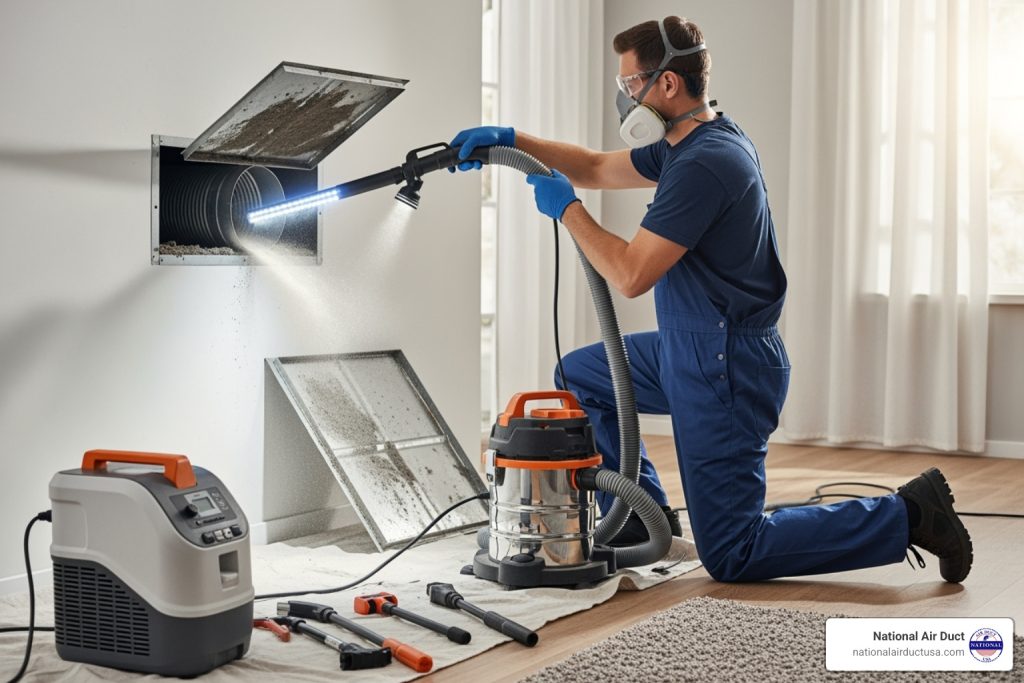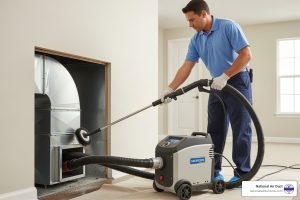Understanding Air Duct Sanitizing: What Homeowners Need to Know
Air duct sanitizing is a specialized treatment that goes beyond regular cleaning to kill bacteria, mold, and other microorganisms in your HVAC system. Unlike basic duct cleaning that removes dust and debris, sanitizing uses antimicrobial chemicals to target harmful microbes that can affect your family’s health.
Quick Answer: What is Air Duct Sanitizing?
- Purpose: Kills 99.9% of bacteria and reduces microorganisms in air ducts
- Method: Chemical application (usually fogging) after thorough cleaning
- When needed: After mold growth, water damage, pest infestations, or health concerns
- Duration: Effects last approximately 6 months
- Cost: Typically an add-on service to regular cleaning ($450-$1,000 total)
- Safety: EPA-registered products are safe when applied by professionals
As Mark Zarzeczny, NADCA President, points out: “I’ve seen people use foggers and just spray it in a return, and they’re charging an awful lot of money.” This highlights why understanding the difference between legitimate sanitizing and ineffective treatments is crucial for New York homeowners.
Since indoor air can be two to five times more polluted than outdoor air, proper HVAC maintenance is essential for your family’s health. However, sanitizing is a targeted solution for specific problems, not a routine necessity.
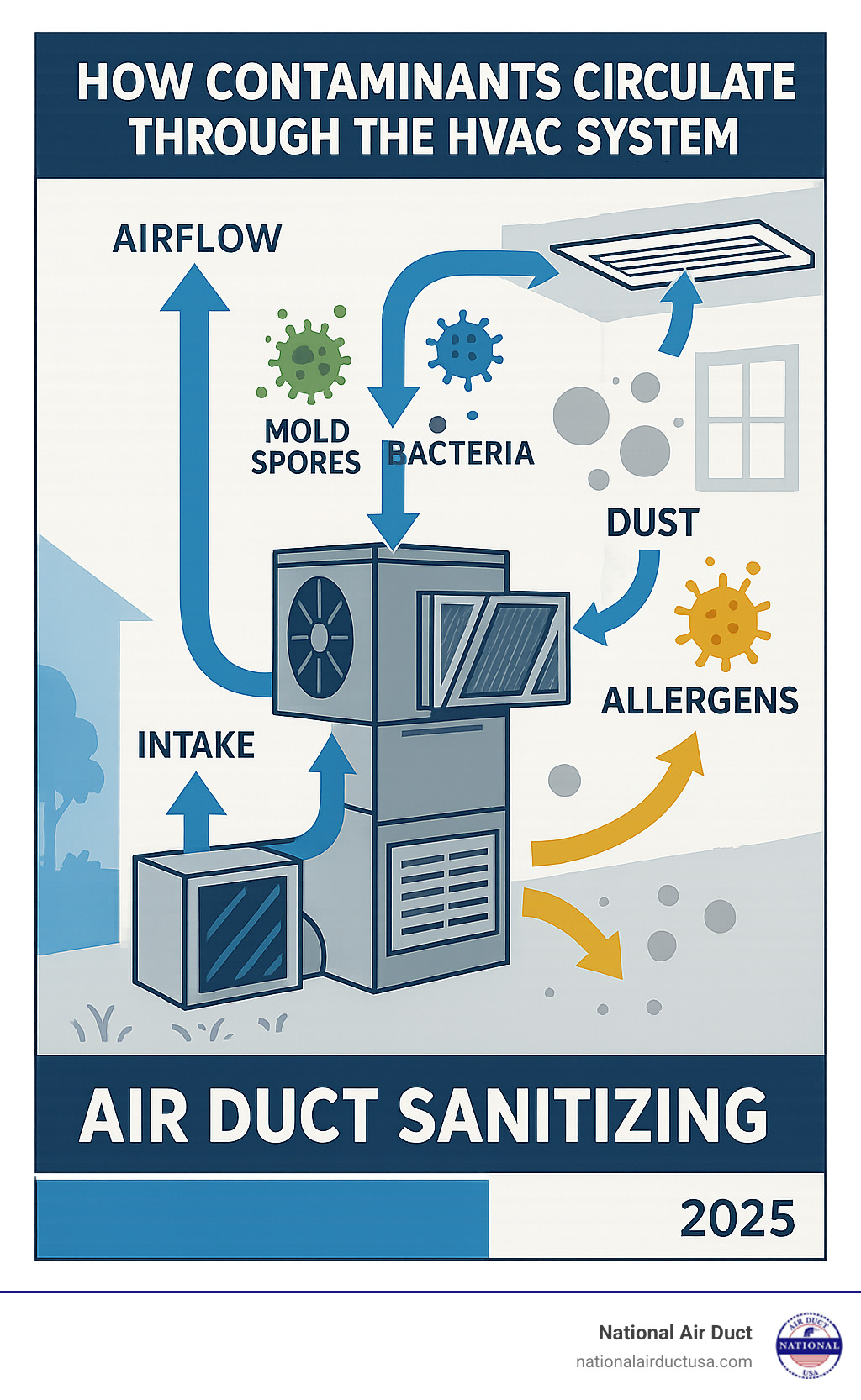
The key is determining if your home needs it. Most homes only need regular cleaning; sanitizing is for special cases like mold or water damage.
Cleaning vs. Sanitizing vs. Disinfecting: What’s the Difference?
You’ve likely heard “cleaning,” “sanitizing,” and “disinfecting” used for air ducts, but they describe different processes. Understanding these differences is key to making the best choice for your home.
At National Air Duct USA, we prioritize source removal—the physical removal of contaminants. Chemical treatments like sanitizers are extra steps used only when necessary and with strict adherence to safety protocols.
Air Duct Cleaning
Air duct cleaning is the essential first step for healthy indoor air. It involves physically removing dust, dander, and debris from your entire HVAC system—ducts, coils, drain pan, vents, blower, and filters. As NADCA explains, cleaning only the ducts is ineffective, as contaminants from uncleaned parts will quickly recirculate.
We use powerful vacuums and agitation tools (brushes, air whips) to loosen and extract debris without releasing it into your home. This thorough source removal improves airflow, reduces dust, and boosts HVAC efficiency. Learn more about our comprehensive Residential Air Duct Cleaning services.
Air Duct Sanitizing
After a thorough cleaning, air duct sanitizing can provide extra help. The EPA defines a sanitizer as a product that reduces bacteria on a surface, typically by 99.9%, but it may not eliminate all microorganisms or bacterial spores. Sanitizing involves applying antimicrobial products inside the ducts, usually via fogging, to reduce bacteria and related odors. It’s an add-on service to address specific issues that cleaning alone can’t solve.
Air Duct Disinfecting
Air duct disinfecting is a step above sanitizing. It aims to eliminate specific, tougher microorganisms like fungi, viruses, and a wider range of bacteria, representing a higher standard of microbial kill. Due to federal regulations (FIFRA), no company can legally claim 100% effectiveness or sterility. Our focus is always source removal first, with chemical treatments used as a necessary improvement. For targeted solutions, see our Disinfecting Air Duct services.
Here’s a quick way to compare these three processes:
| Feature | Air Duct Cleaning | Air Duct Sanitizing | Air Duct Disinfecting |
|---|---|---|---|
| Purpose | Physical removal of dust, debris, allergens | Reduces 99.9% of bacteria | Kills specific microorganisms (viruses, fungi, bacteria) |
| Method | Mechanical agitation & powerful vacuum (source removal) | Chemical application (fogging) after cleaning | Chemical application (fogging) after cleaning |
| Outcome | Improved airflow, reduced dust, improved HVAC efficiency | Reduced bacterial odors, inhibited bacterial growth | Elimination of specific pathogens, mold, and odors |
| Primary Goal | Cleanliness & HVAC efficiency | Bacterial reduction | Pathogen elimination |
| Legality of Claim | “Clean” is appropriate | “Sanitize” must be carefully worded due to regulations (cannot claim 100% or complete sterility) | “Disinfect” must be carefully worded due to regulations (cannot claim 100% or complete sterility) |
When is Air Duct Sanitizing Necessary?
While regular cleaning is key for healthy air, air duct sanitizing isn’t a routine service for every home. It’s a targeted treatment for specific problems, not a general check-up. At National Air Duct USA, we recommend sanitizing to solve a specific issue or after a known contamination event.
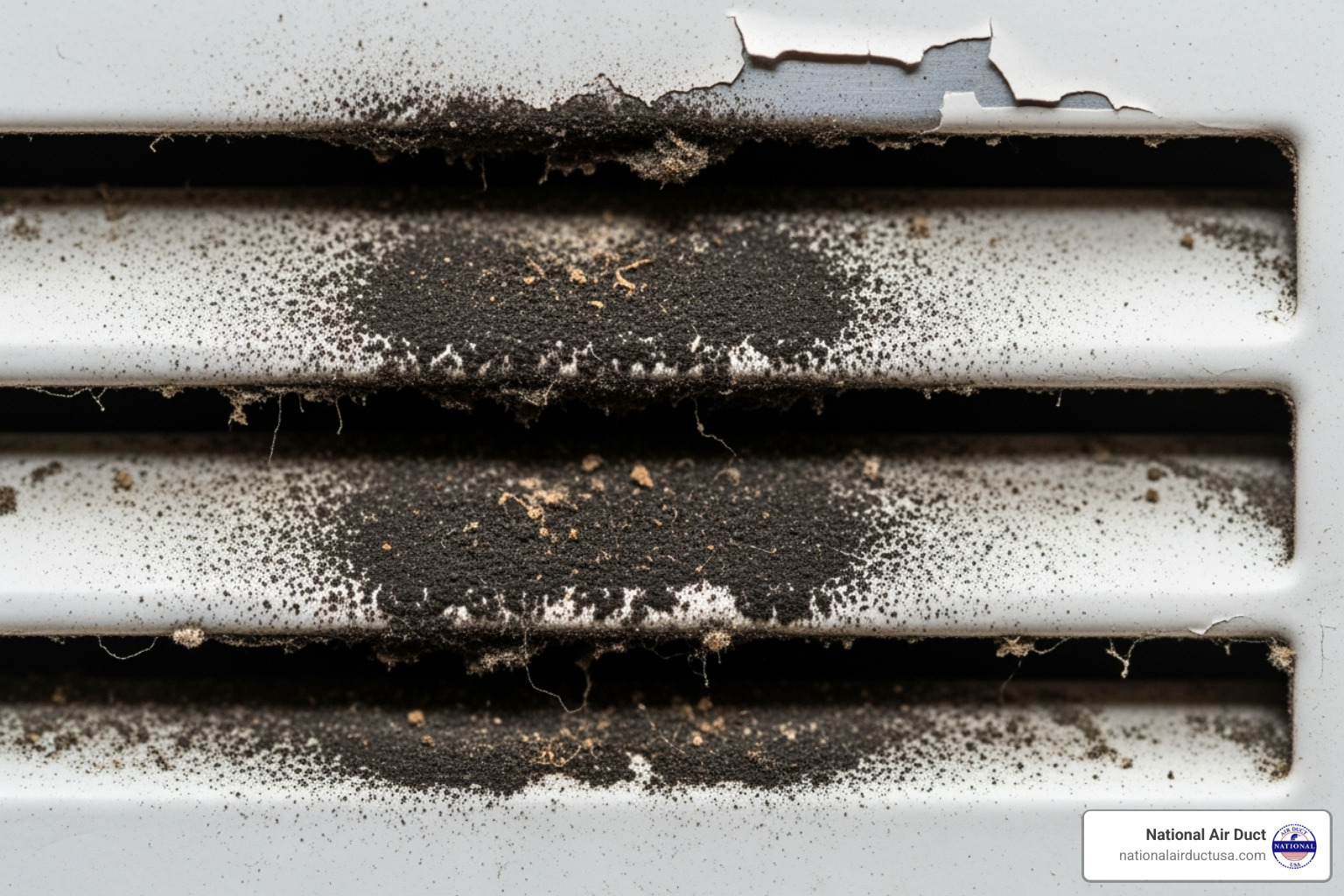
After Mold or Water Damage
If you’ve had a water leak, flood, or high humidity leading to visible mold or a musty odor, air duct sanitizing is highly recommended. Ductwork provides the ideal cool, dark, and damp environment for mold to thrive. Cleaning physically removes mold, but sanitizing kills remaining spores to help prevent regrowth. After sewage contamination, sanitizing is essential to eliminate harmful microorganisms. For about $50, a lab can test a sample for mold, confirming if this service is necessary.
Following a Pest Infestation
If pests like rodents or insects have nested in your ducts, you’re dealing with more than just droppings and nests. They leave behind bacteria, viruses, and persistent odors. After a deep cleaning removes the physical traces, air duct sanitizing eliminates the harmful bacteria and neutralizes lingering odors left by pests, making ducts less attractive for future infestations.
For Specific Health Concerns
For households with individuals suffering from severe allergies, asthma, or compromised immune systems, clean air is crucial. Reducing airborne pathogens and irritants through sanitizing can significantly improve their health and comfort. After a contagious illness, sanitizing your ducts can also help reduce the circulation of lingering germs through your HVAC system.
After a Home Renovation
Home renovations create significant dust. Drywall dust, sawdust, and chemical fumes can get sucked into your HVAC system and recirculated. While a thorough post-renovation cleaning is the primary solution (see our Renovation Air Duct Cleaning service), sanitizing is a beneficial follow-up if you’re concerned about chemical fumes or potential mold from construction moisture. It ensures your air is as fresh as your new space.
The Professional Process: How It’s Done and Is It Safe?
Air duct sanitizing is a precise process requiring special knowledge and equipment. At National Air Duct USA, our certified technicians follow strict NADCA standards to ensure every job is done professionally, effectively, and safely for your family’s health.
The Sanitizing and Disinfecting Method
The most vital first step is a thorough, professional air duct cleaning. Applying sanitizers to dirty ducts is ineffective; all physical contaminants must be removed first. This includes a deep clean of the system’s coils. Learn more about our Coil Cleaning services.
After cleaning, we apply antimicrobial solutions via “fogging.” Our equipment creates a fine mist from an EPA-registered solution, which coats the entire interior surface of your ductwork. A crucial part of the process is “dwell time,” the time the solution must sit to be effective—usually 5 to 20 minutes. Our experts ensure sufficient contact time to kill microorganisms before restarting your system.
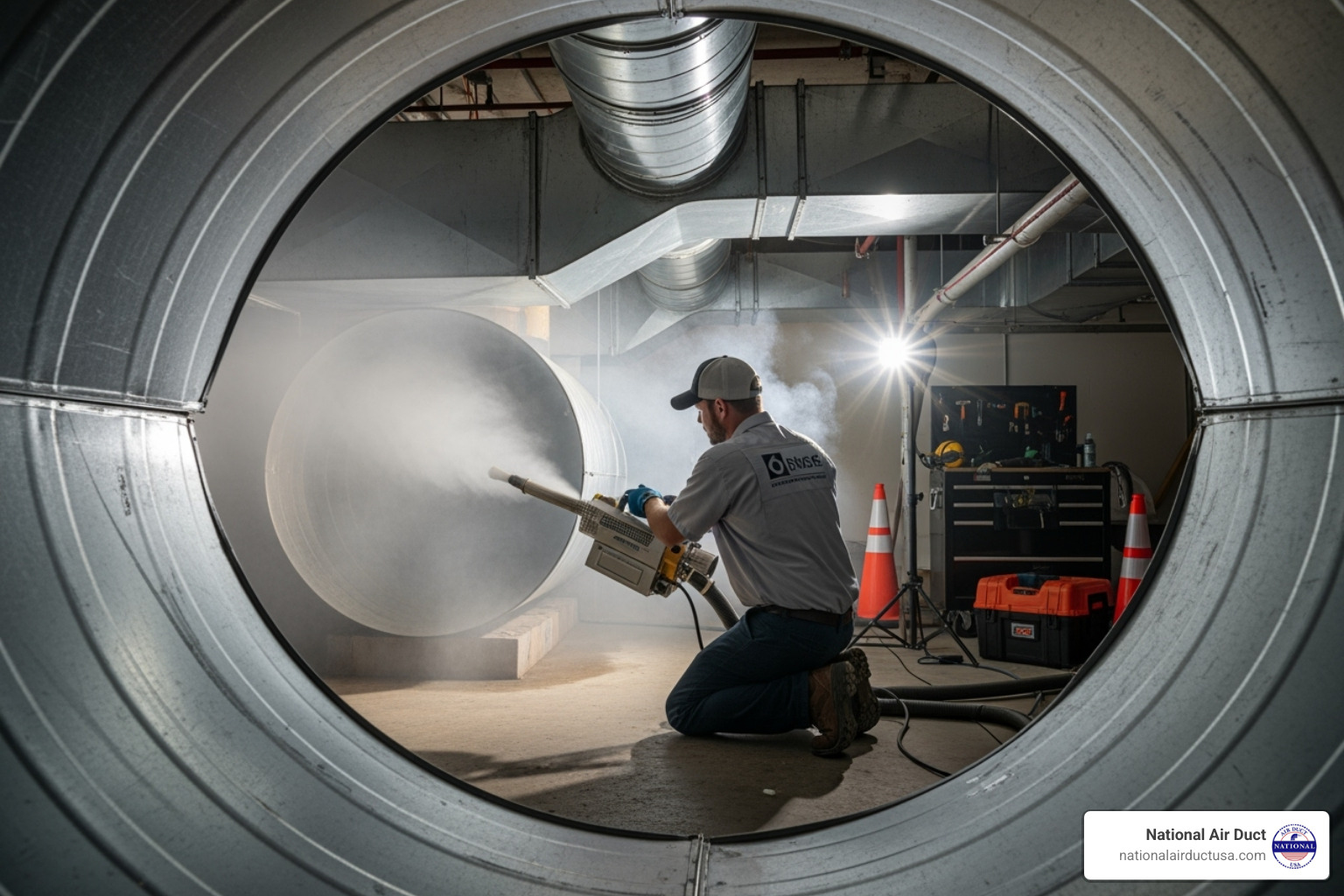
Types of Sanitizing Products and Their Safety
Your safety is our top priority. We only use EPA-registered products specifically designed for HVAC systems, formulated to be safe and effective when applied by trained professionals. Common products include:
- Botanical Sanitizers: Nature-based solutions made from plant extracts that are non-corrosive and have a lower environmental impact.
- Antimicrobial Sprays: Powerful, hospital-grade solutions. Products like Sporicidin are highly effective, killing nearly 100% of bacteria, viruses, and fungi in 10 minutes. Trusted in medical settings, it has the lowest EPA toxicity rating, making it a safe choice when applied correctly.
- UV Light Systems: For continuous sanitizing, whole-house UV air duct sanitizers can be installed in your ductwork. They use UV-C light to kill airborne microbes like bacteria and mold spores. While they don’t remove dust, they are excellent for preventing microbial growth. Learn more about our UV Lights Installation services.
We take every precaution when applying chemical sanitizers. Occupants and pets typically need to leave the home for a few hours (usually 2-8) to allow for proper ventilation. We provide Safety Data Sheets (SDS) for all products and strictly follow label instructions, as required by federal law (FIFRA).
DIY vs. Professional: A Word of Caution
While DIY projects are appealing, we strongly advise against DIY air duct sanitizing. It’s a task for trained professionals, and attempting it yourself can be risky and ineffective.
- Risks of Improper Application: Incorrect application can lead to unsafe levels of chemicals circulating in your home’s air.
- Chemical Exposure: Handling professional-grade solutions without proper personal protective equipment (PPE) is hazardous.
- Ineffective Results: Spraying a scented solution into vents only masks odors. True sanitizing requires a clean surface, the correct product, proper dwell time, and professional tools.
- Ozone Generators: We caution against using ozone generators. They are often ineffective and cannot replace the crucial physical cleaning and targeted antimicrobial application that professionals provide.
Hiring a non-professional is potentially unsafe and a waste of money. Certified technicians, like ours at National Air Duct USA, have the training, equipment, and expertise to perform the service safely and effectively.
Effectiveness, Frequency, and Cost of Air Duct Sanitizing
Let’s be honest about what to expect from air duct sanitizing in terms of results, frequency, and cost. Clear expectations help you make the best decision for your home and budget.
How Effective Is It and How Long Does It Last?
The truth is, air duct sanitizing doesn’t create a permanently sterile environment, but it makes a significant difference when needed. Proper application of EPA-registered solutions by certified technicians substantially reduces harmful microorganisms. It’s like washing your hands: highly effective, but not permanent. As your HVAC system runs, some recontamination naturally occurs over time.
The effects of professional sanitizing typically last about six months. However, this timeline depends on your home’s unique conditions, such as humidity levels, pets, or ongoing moisture issues.
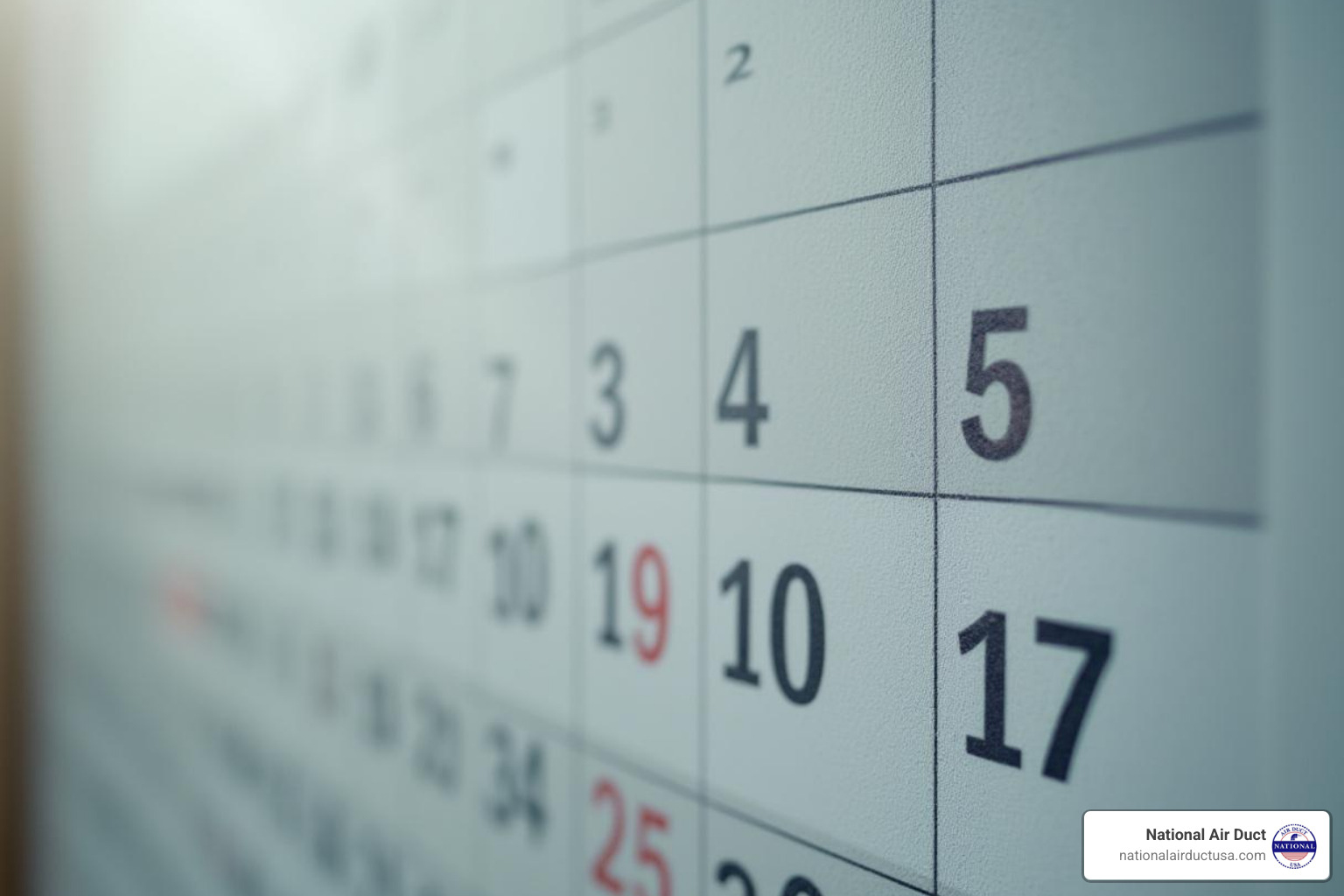
How Often Should Air Ducts Be Sanitized?
Unlike regular air duct cleaning (recommended every two to three years), air duct sanitizing isn’t a routine service. It’s done on an as-needed basis to solve a specific problem. Most homes only need sanitizing after events like water damage or pest infestations. However, households with persistent mold, severe allergies, or compromised immune systems may benefit from sanitizing every six months.
Understanding the Cost
Regarding cost, air duct sanitizing is an add-on to a comprehensive cleaning because sanitizing dirty ducts is ineffective. The EPA estimates whole-house air duct cleaning costs $450 to $1,000. Sanitizing is an additional cost influenced by several factors:
- Home size, system accessibility, and the level of contamination all affect the final price. Extensive mold or pest issues require more intensive treatment.
- The choice of specific products, such as specialized sanitizers or installing a UV light system (around $800 plus installation), will also affect the cost.
We provide detailed quotes. Be wary of low-priced “specials,” as they often involve hidden fees or ineffective services. A NADCA-certified professional will be upfront about costs and services. Your family’s health deserves transparency and expertise, not gimmicks.
Frequently Asked Questions about Air Duct Sanitizing
Here are answers to common questions we receive from homeowners in Westbury, NY, and the greater New York area about air duct sanitizing.
Can sanitizing get rid of bad smells in my vents?
Yes, air duct sanitizing can eliminate bad smells coming from your vents. If odors are caused by mold, mildew, bacteria, or pests, sanitizing targets the source. It kills the odor-producing microorganisms, eliminating the smell. This differs from “deodorizing,” which only masks smells temporarily. Professional air duct sanitizing, performed after a thorough cleaning, eliminates the microbial source of the odor for a lasting solution.
Are the chemicals used for air duct sanitizing safe for my pets and children?
Safety is our top priority. When applied by our certified professionals, EPA-registered products designed for HVAC systems (like Sporicidin) are very safe and have low toxicity ratings. The EPA regulates these products under the Federal Insecticide, Fungicide, and Rodenticide Act (FIFRA).
As a precaution, we recommend that all occupants, including pets, vacate the home during application and for a ventilation period afterward, typically two to eight hours. This allows any fumes to clear completely. After the ventilation period, your home is safe to re-enter. We can provide Safety Data Sheets (SDS) for all products we use for your peace of mind.
Do I need to sanitize the ducts in a brand-new house?
No, you typically don’t need to sanitize the ducts in a new house. The exception is if there’s a specific concern, like mold growth from construction moisture. New homes often have construction debris (drywall dust, sawdust) in the ducts. A thorough post-construction Clean Ventilation System cleaning is usually sufficient. Sanitizing is only needed if there’s evidence of microbial growth from the construction process.
Breathe Easier with a Professional Assessment
The big takeaway is that air duct sanitizing is a specialized service for specific problems, not a routine upgrade for every home. It’s most effective for issues like mold, bacteria from water damage, or post-pest-infestation cleanup. It can also provide significant relief for those with severe allergies or asthma by reducing airborne irritants at the source.
The first step to healthy air is always a thorough, professional air duct cleaning. This “source removal” of dust and debris is the foundation of good indoor air quality.
If you suspect a deeper microbial issue due to musty odors or persistent health concerns, contact us. National Air Duct USA can assess your HVAC system to determine if a comprehensive cleaning is enough or if a disinfecting service is needed. We proudly serve residential clients throughout New York, from Westbury, NY, to New York City.
Ready to clear the air? Contact us today for a professional air duct disinfecting service. We’re here to help you and your family breathe easier, with peace of mind.

